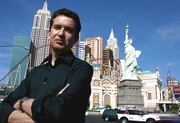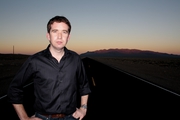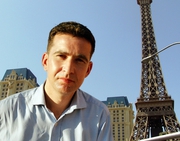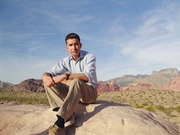In part two of this two-part series, Mark Little goes beyond the hopeful rhetoric of the US election to show us that doubt, not hope, is shaping America’s future.
Bringing us back to the most dynamic part of the United States, the Sunbelt, and its most dynamic cities, including Las Vegas, Mark Little introduces a cast of colourful characters who bring to life the daunting home-grown challenges facing the US. They show how difficult it is for Americans to live out their founding ideals, like the pursuit of happiness, when they are confronted by doubts about recession, environmental crisis, immigration and even their relationship with God.
The final episode in this two-part series brings more of the breath-taking speed and dangerous intensity of modern American life and delivers a unique take on the perilous state of that American dream.
The programme goes out at the earlier time of 10.15 pm.
To understand America, says Mark Little, you need to understand the contradictions that lie at the very heart of the world’s last superpower. Most Americans, says Little, from President to pauper, are keenly tuned into the tensions that exist between a collective love of ritual and the wilder call of the frontier. Most Americans, says Mark, have the pioneer spirit in their very DNA, a spirit that is today at odds with a growing national obsession with the boundaries of home. As the new America seeks to protect the very idea of itself, will the American dream ultimately suffocate and die?
Americans have always mythologized the pioneer, says Mark, as long as the pioneer ultimately submits to the broader consensus, creating new communities out of the disorder of dispersal, creating new Americas at the outposts of its own civilisation. In American Dream: Dead or Alive Mark Little looks at the continuing dispersal and expansion of the United States into its own interior, charting how the American pioneer spirit is alive and well in the 21st century. Visiting Phoenix, America’s fastest growing city, Mark unveils a city still in the grasp of the American dream.
If the American dream is still alive, says Mark, then it’s in these sun-belt states. In an arc running through Arizona, New Mexico and Texas, the new political and social epicentre of an evolving empire is emerging. Reagan was the first sun-belt state president, espousing the values of the frontier in a cosier framework of home and religion, picket fences and Stetsons. Reagan articulated, says Little, an old belief system, re-invigorating an aggressive foreign policy that reached its popular consensus in George W Bush.
But where has Bush taken the American dream? The answer lies somewhere in Bush’s promise of compassionate conservatism. But while perfectly suited to a presidency in the media age, were the irreconcilable contradictions of the Bush brand ultimately undone in the wake of 9/11? In short, did Bush’s brand of American dream simply crack and fold in the fall-out of his search for freedom, a definition of freedom that many, both at home and abroad, were to come to reject?
Produced for RTÉ by Animo, part one of American Dream: Dead or Alive aired on RTÉ One on February 28th.
Mark Little was born in 1968. He studied Economics and Politics in Trinity College, and graduated in 1990. He joined RTÉ as a television reporter in 1991, working during the Ben Dunne scandal. Mark was later appointed RTÉ’s first Washington Correspondent in September 1995, covering two presidential elections as well as President Bill Clinton’s involvement in the Irish peace process, and his state visits to Ireland. In January 2001 Mark became RTÉ’s Foreign Affairs Correspondent, reporting on the impact of 9/11 from the United States, Israel and Iran. He spent seven weeks in Northern Iraq reporting on the war. In 2001, he was named Television Journalist of the Year for his reporting in Afganistan. Mark is currently co-presenter of RTÉ Television’s current affairs programme Prime Time. He is the author of the non-fiction books Turn Left at Greenland and Zulu Time, published in June 2002 and March 2004 respectively.



